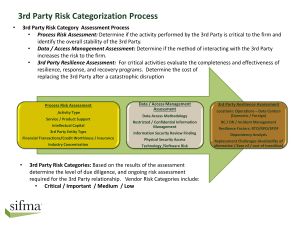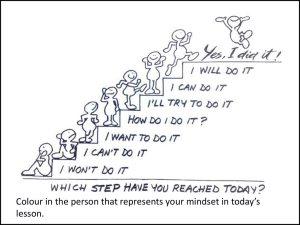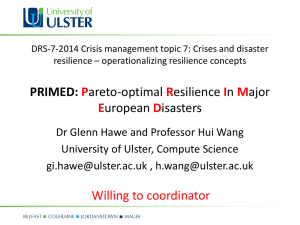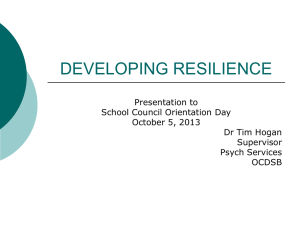Building Resilience Across Contexts and Cultures
advertisement
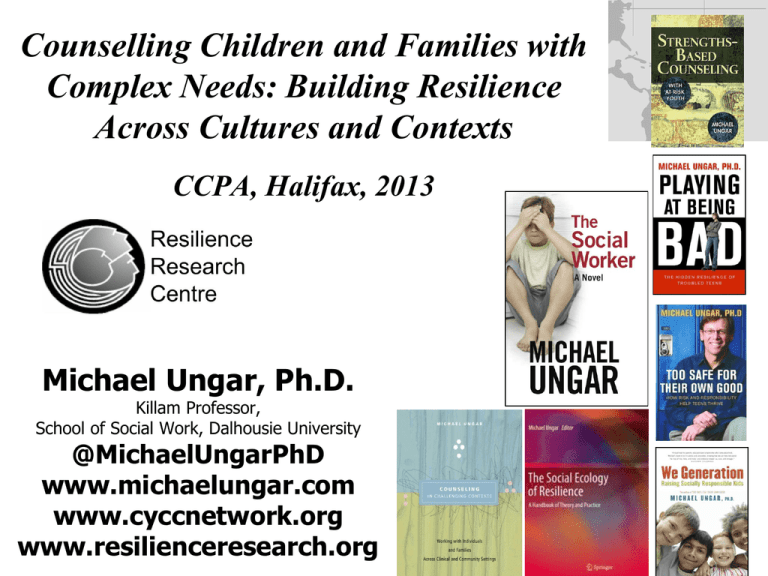
Counselling Children and Families with Complex Needs: Building Resilience Across Cultures and Contexts CCPA, Halifax, 2013 Michael Ungar, Ph.D. Killam Professor, School of Social Work, Dalhousie University @MichaelUngarPhD www.michaelungar.com www.cyccnetwork.org www.resilienceresearch.org High Well-being Low “Disorder” High “Disorder” Low Well-being Hidden Resilience Actual Expected Acute Stressor/trauma ‘Hidden Resilience’ Chronic Stressors Time Three Definitions Strengths are population-wide internal and external assets Associated with prosocial behaviour and outcomes A ‘thin description’ of success: lacks context Resilience is positive outcomes/strengths shown under adversity Context sensitive Hidden resilience is socially marginalized adaptation in stressful environments where resources are few or solutions devalued Five things we know about Resilience: #1-For the most disadvantaged children, facilitative environments (like good schools and safe streets) can be more influential to the processes associated with resilience than individual factors (like personality or self-esteem) “Nurture trumps nature” The challenge is to know which protective factor is best suited to which type of problem for which person in which context 2008 British Columbia Adolescent Health Survey Five things we know about Resilience: #2-The environments that are most facilitative of resilience are those that help individuals, families, and communities to navigate to the resources that are the most meaningful to them Five things we know about Resilience: #3-The greater a child’s exposure to adversity, the more likely the child is to benefit from protective factors (like a mentor or extra-curricular activities) Differential impact Examples: Conduct disorder, obesity, demobilizing gang members Five things we know about Resilience: #4-An adaptive coping strategy that works well at one point in time may have long-term negative consequences. Five things we know about Resilience: #5-Culture and context matter. Seven Resilience Resources cultural adherence relationships cohesion access to material resources identity power & control social justice Resilience is… In the context of exposure to significant adversity, resilience is both the capacity of individuals to navigate their way to the psychological, social, cultural, and physical resources that sustain their well being, and their capacity individually and collectively to negotiate for these resources to be provided and experienced in culturally meaningful ways. A Social Ecological Approach (S.E.A.) to Counseling S.E.A. is a model of clinical intervention that integrates case management and advocacy into direct practice with individuals and families S.E.A. nurtures people’s abilities to navigate towards, and negotiate for, the health promoting resources that are meaningful to them S.E.A.: Broadens the scope of clinical practice for counselors working from other approaches (CBT; Solution-focused Therapy; EFT; FFT; Narrative Therapy, etc.) Focuses on individual, relational and social determinants of health (mental and physical) Case Illustration: Brian Resources Individuals, Families and Communities Context Culture Seven Resources Meaning Navigation and Negotiation © Michael Ungar, Ph.D. A Social Ecological Approach (S.E.A.) to Counseling Navigation Resources Individuals, Families and Communities Context Culture Seven Resources Meaning Negotiation © Michael Ungar, Ph.D. Theory of Change People living in challenging contexts change when their natural supports, programs and interventions, and social policies help them: Navigate effectively Negotiate effectively Find resources that are culturally and contextually meaningful -.03 -.21* .18* -.14 .13 Service Use Experience Individual Risk Contextual Risk -.17* .53* Life time Service Use Accumulation .33* -.38* .07 -.30* Resilience .37* Functional Outcomes Service Use Experience .33* Resilience Functional Outcomes .37* Help People Navigate External Resources Cultural spaces, diverse curriculum, etc. Mentors, teachers, extended family, etc. relationships Opportunities to use talents, experience respect, etc. cultural adherence cohesion access to material resources identity Opportunities to participate, make a contribution, etc. Experiences at School, Religious Institutions, etc. power & control Employment, housing, clothes, etc. social justice Laws, antidiscrimination efforts, etc. Internal Resources Cultural identification, cultural practices Quality of attachment to peers and caregivers Self-worth, selfesteem, assessment of strengths relationships cultural adherence cohesion access to material resources identity Attribution style (internality/external ity), efficacy Sense of engagement with others, attitudes towards belonging, spirituality power & control Awareness of resources such as educational opportunities and health care social justice Knowledge and experience of one’s rights Help People Negotiate Thank you! Michael Ungar, Ph.D. Killam Professor, School of Social Work, Dalhousie University @MichaelUngarPhD www.michaelungar.com www.cyccnetwork.org www.resilienceresearch.org



